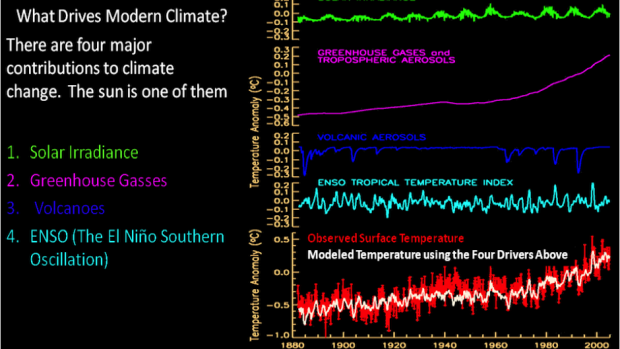
"Most conventional theories expect that global temperatures will continue to increase as CO2 levels continue to rise, as they have done since 1850. What’s striking is that since 2002, global temperatures have actually declined – matching a decline in CFCs in the atmosphere,” Professor Lu said. “My calculations of CFC greenhouse effect show that there was global warming by about 0.6 °C from 1950 to 2002, but the earth has actually cooled since 2002. The cooling trend is set to continue for the next 50-70 years as the amount of CFCs in the atmosphere continues to decline.”
Ultima modifica di robertino; 15/10/2016 alle 22:29
" All weather on Earth, from the surface of the planet out into space, begins with the Sun. Space weather and terrestrial weather (the weather we feel at the surface) are influenced by the small changes the Sun undergoes during its solar cycle.
The most important impact the Sun has on Earth is from the brightness or irradiance of the Sun itself. The Sun produces energy in the form of photons of light. The variability of the Sun's output is wavelength dependent; different wavelengths have higher variability than others. Most of the energy from the Sun is emitted in the visible wavelengths (approximately 400 – 800 nanometers (nm)). The output from the sun in these wavelengths is nearly constant and changes by only one part in a thousand (0.1%) over the course of the 11-year solar cycle.
At Ultraviolet or UV wavelengths (120 – 400 nm), the solar irradiance variability is larger over the course of the solar cycle, with changes up to 15%. This has a significant impact on the absorption of energy by ozone and in the stratosphere. At shorter wavelengths, like the Extreme Ultraviolet (EUV), the Sun changes by 30% - 300% over very short timescales (i.e. minutes). These wavelengths are absorbed in the upper atmosphere so they have minimal impact on the climate of Earth. At the other end of the light spectrum, at Infrared (IR) wavelengths (800 – 10,000 nm), the Sun is very stable and only changes by a percent or less over the solar cycle.
The total wavelength-integrated energy from sunlight is referred to as the Total Solar Irradiance (TSI). It is measured from satellites to be about 1365.5 Watts/m2 at solar minimum to 1366.5 Watts/m2 at solar maximum. An increase of 0.1% in the TSI represents about 1.3 Watts/m2 change in energy input at the top of the atmosphere. This energy is scattered, reflected, and absorbed at various altitudes in the atmosphere, but the resulting change in the temperature of the atmosphere is measurable. It should be noted that the change in climate due to solar variability is likely small, but more research needs to be done.
There are other types of space weather that can impact the atmosphere. Energetic particles penetrate into the atmosphere and change the chemical constituents. These changes in minor species such as Nitrous Oxide (NO) can have long lasting consequences in the upper and middle atmosphere, however it has not been determined if these have a major impact on the global climate of Earth.
The duration of solar minimum may also have an impact on Earth's climate. During solar minimum there is a maximum in the amount of Cosmic rays, high energy particles whose source is outside our Solar system, reaching earth. There is a theory that cosmic rays can create nucleation sites in the atmosphere which seed cloud formation and create cloudier conditions. If this were true, then there would be a significant impact on climate, which would be modulated by the 11-year solar cycle. "

Ci stiamo raffreddando è un ipotesi ,discutibile ma un ipotesi....che il GW sia stabile dal 2002 circa è invece indiscutibile come trend di breve periodo e non sarà, PER ORA, di certo inficiato dagli ultimi due anni caldi caratterizzati dal Big nino 2015/16.... un trend è già poco definibile tale su un arco temporale di 14/15 anni, figuriamoci su 2/3.
magari sarebbe meglio evitare le incomprensioni , ma in Meteorologia ( tendenze stagionali ) possono esserci di tipo gergali , lessicali , prospettiche ect.
IL Clima e' una bella " macedonia " di tante Variabili , oltre le pere e mele mettiamoci pure i lamponi e banane , percoche e albicocche .
Segnalibri